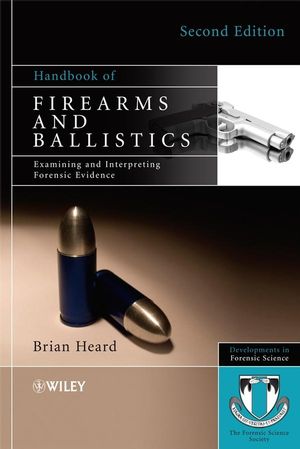Handbook of Firearms and Ballistics: Examining and Interpreting Forensic Evidence, 2nd EditionISBN: 978-0-470-69460-2
Hardcover
416 pages
December 2008
 This is a Print-on-Demand title. It will be printed specifically to fill your order. Please allow an additional 10-15 days delivery time. The book is not returnable.
|
||||||
Acknowledgements.
Foreword.
1 Firearms.
1.1 A Brief History of Firearms.
1.2 Weapon Types and Their Operation.
1.3 Proof Marks.
Further Reading.
2 Ammunition.
2.1 A Brief History of Ammunition.
2.2 Ammunition Components.
2.3 Non-toxic Shot.
2.4 A Brief History of Propellants.
2.5 Priming Compounds and Primers.
2.6 Headstamp Markings on Ammunition.
3 Ballistics.
3.1 Internal, External and Terminal Ballistics.
3.2 Internal Ballistics.
3.3 External Ballistics.
3.4 Terminal Ballistics.
4 Forensic Firearms Examination.
4.1 A Brief History of Forensic Firearms Identification.
4.2 Rifling Types and Their Identification.
4.3 Fluted, Annular Ringed, Helical, Perforated and Oversized Chambers.
4.4 Basic Concepts of Striation Matching.
4.5 Basic Methodology Used in Comparison Microscopy.
4.6 Mathematical Proof of Striation Matches.
4.7 Accidental Discharge.
4.8 Identification of Calibre from the Bullet Entry Hole.
4.9 Ricochet Analysis.
4.10 Bullet Penetration and Trajectory through Glass.
5 Range of Firing Estimations and Bullet Hole
Examinations.
5.1 Introduction.
5.2 The Use of X-ray Photography.
5.3 Range of Firing Estimations for Pistols and Rifles.
5.4 Chemical Tests for Range of Firing Estimations and Bullet Entry/Exit Hole Identification.
5.5 Range of Firing Estimations for Shotguns.
6 Gunshot Residue Examination.
6.1 Introduction.
6.2 Formation of Discharge Residue.
6.3 Distribution of GSR Particles.
6.4 Identification of GSR Particles.
6.5 The Use of the SEM for GSR Detection.
6.6 Sample Collection.
6.7 GSR Retention.
6.8 Conservation of GSR Particles on the Hands.
6.9 GSR Distribution on the Hands.
6.10 Identification of Type of Ammunition, Country of Origin from GSR Analysis.
6.11 Environmental Contaminants.
6.12 Sources of Elements Commonly Found in Lead-Based GSRs.
6.13 Extending the Recovery Period for GSR.
7 Gun-Handling Tests.
7.1 Introduction.
7.2 Methodology for Ferrozine Use.
7.3 Case Notes.
8 Restoration of Erased Numbers.
8.1 Introduction.
8.2 Methods Used for Removal of Serial Numbers.
8.3 Theory behind Number Restoration.
8.4 Non-recoverable Methods of Number Removal.
8.5 Practice of Number Restoration.
8.6 Chemical Methods of Restoration.
8.7 Reagents Used for Various Metals.
8.8 Electrolytic Methods of Restoration.
8.9 Reagents Used.
8.10 Ultrasonic Cavitation for Restoration.
8.11 Magnetic Particle Method for Restoration.
8.12 Other Methods of Restoration.
8.13 Laser-Etched Serial Numbers and Bar Codes and Their Restoration.
9 Qualifying the Expert and Cross-Examination Questions.
9.1 Introduction.
9.2 General Background Questions.
9.3 Comparison Microscopy.
9.4 GSRs.
9.5 Ferrozine Test.
9.6 Standard of Review: ‘Daubert Trilogy’.
10 Classification of Firearm-Related Death.
10.1 Multiple-Shot Suicides.
11 Glossary.
Appendix 1 Important dates in the History of Firearms from 1247.
Appendix 2 GSR results for Chinese and USSR ammunition.
Appendix 3 Primer content of some cartridge-operated nail guns.
Appendix 4 Commercial and General Abbreviations for Bullet Configurations.
Appendix 5 Trade Names.
Appendix 6 Gun Marks.
Appendix 7 Powder Burn Rate.
Appendix 8 Hearing Loss.
Appendix 9 General Firearms Values Conversion Table.
Index.



